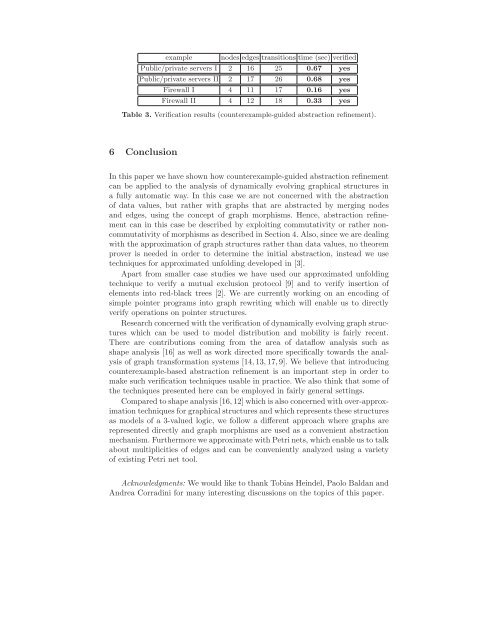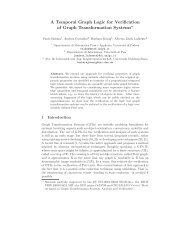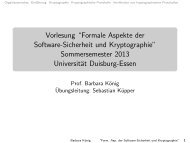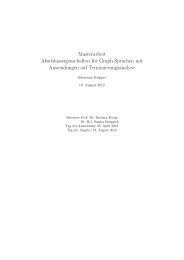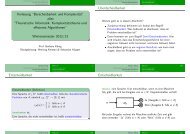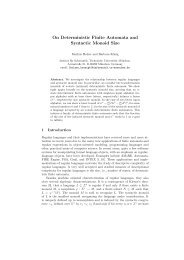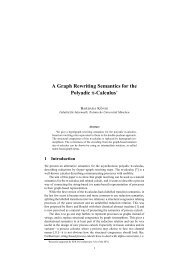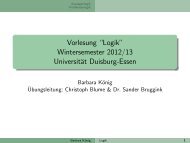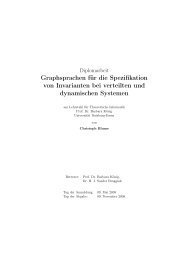Counterexample-guided Abstraction Refinement for the Analysis of ...
Counterexample-guided Abstraction Refinement for the Analysis of ...
Counterexample-guided Abstraction Refinement for the Analysis of ...
You also want an ePaper? Increase the reach of your titles
YUMPU automatically turns print PDFs into web optimized ePapers that Google loves.
example nodes edges transitions time (sec) verifiedPublic/private servers I 2 16 25 0.67 yesPublic/private servers II 2 17 26 0.68 yesFirewall I 4 11 17 0.16 yesFirewall II 4 12 18 0.33 yesTable 3. Verification results (counterexample-<strong>guided</strong> abstraction refinement).6 ConclusionIn this paper we have shown how counterexample-<strong>guided</strong> abstraction refinementcan be applied to <strong>the</strong> analysis <strong>of</strong> dynamically evolving graphical structures ina fully automatic way. In this case we are not concerned with <strong>the</strong> abstraction<strong>of</strong> data values, but ra<strong>the</strong>r with graphs that are abstracted by merging nodesand edges, using <strong>the</strong> concept <strong>of</strong> graph morphisms. Hence, abstraction refinementcan in this case be described by exploiting commutativity or ra<strong>the</strong>r noncommutativity<strong>of</strong> morphisms as described in Section 4. Also, since we are dealingwith <strong>the</strong> approximation <strong>of</strong> graph structures ra<strong>the</strong>r than data values, no <strong>the</strong>oremprover is needed in order to determine <strong>the</strong> initial abstraction, instead we usetechniques <strong>for</strong> approximated unfolding developed in [3].Apart from smaller case studies we have used our approximated unfoldingtechnique to verify a mutual exclusion protocol [9] and to verify insertion <strong>of</strong>elements into red-black trees [2]. We are currently working on an encoding <strong>of</strong>simple pointer programs into graph rewriting which will enable us to directlyverify operations on pointer structures.Research concerned with <strong>the</strong> verification <strong>of</strong> dynamically evolving graph structureswhich can be used to model distribution and mobility is fairly recent.There are contributions coming from <strong>the</strong> area <strong>of</strong> dataflow analysis such asshape analysis [16] as well as work directed more specifically towards <strong>the</strong> analysis<strong>of</strong> graph trans<strong>for</strong>mation systems [14, 13, 17, 9]. We believe that introducingcounterexample-based abstraction refinement is an important step in order tomake such verification techniques usable in practice. We also think that some <strong>of</strong><strong>the</strong> techniques presented here can be employed in fairly general settings.Compared to shape analysis [16, 12] which is also concerned with over-approximationtechniques <strong>for</strong> graphical structures and which represents <strong>the</strong>se structuresas models <strong>of</strong> a 3-valued logic, we follow a different approach where graphs arerepresented directly and graph morphisms are used as a convenient abstractionmechanism. Fur<strong>the</strong>rmore we approximate with Petri nets, which enable us to talkabout multiplicities <strong>of</strong> edges and can be conveniently analyzed using a variety<strong>of</strong> existing Petri net tool.Acknowledgments: We would like to thank Tobias Heindel, Paolo Baldan andAndrea Corradini <strong>for</strong> many interesting discussions on <strong>the</strong> topics <strong>of</strong> this paper.


